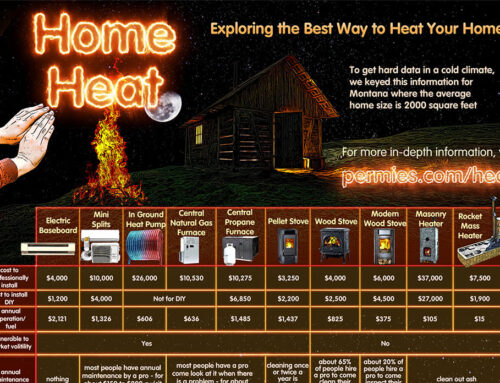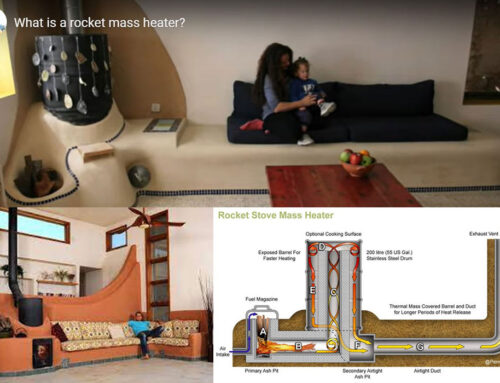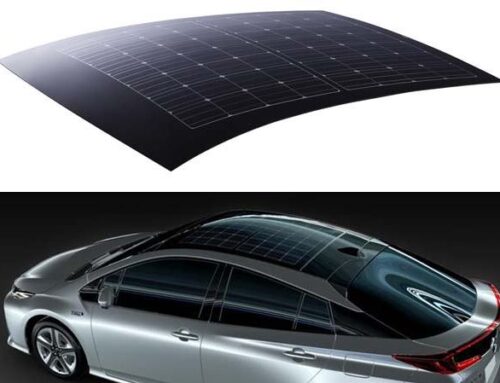Part 2, HEPA Filters, DYI Air Purifiers, Effectiveness of House Plants and more on AQI and PM2.5 in California
If you have not already, click here and read Part 1 on “Filtering Wildfire Smoke”
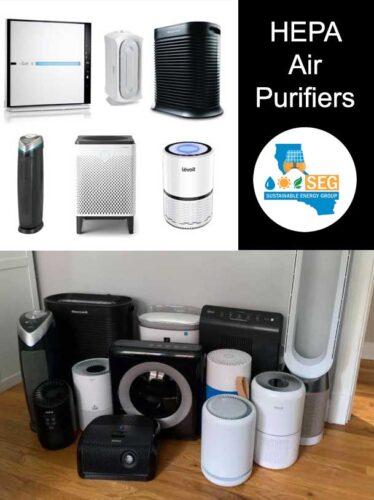


As we approach the most acres burned in a season in California’s recent history the issue of bad air quality is not going away. I myself invested in a air purifier and now wear an N95 mask if I am outside for extended periods of time or being active even for short periods.
HEPA air purifiers and MERV 13 or above filters can not only filter the smoke, but also filter COVID-19.
After reading Ray Darby’s assessment in the previous article you are probably still wondering if you need to take action or if the action you take will be good or bad for you HVAC system. Although I can’t answer if your HVAC system will be negatively effected by changing it’s filter, other ways to avoid this question are either buying a stand along, plugin HEPA rated air purifier or building your own.
SEG Note: If you were thinking of getting a battery backup or generator installed by us, you will want to make sure you have power to the purifier wherever it will be plugged in. Aka, consider your air purifier as a critical backed up load. Running your HVAC (air conditioner) on a battery or generator could deplete it’s power/gas quickly, therefore considering a stand alone, plugin HEPA filter that uses less energy would be a smart option in power outage situations and PSPS’s.
What air purifier brand is the best?
- Choose a known name brand air purifier (see why below)
- Make sure you get the right powered purifier for the size of your room
- Get a least a HEPA rated purifier and with a carbon filter
- Does it have a warranty?
If you go ahead and do a good search for best HEPA filters you will see that most will say a few brands work the best but some are almost impossible to find right now.
For me, I believe in buying a known name brand only because you will have to buy a replacement filter later on and you don’t want to find out your filter is no longer on the market because it was some off brand Amazon purchase.
Therefore, from what I notice:
- Coway and Honeywell get great marks although are hard to find in my search today.
- Blueair and Levoit showed up a lot as well. Each seem ok, but the smaller versions may not work that well if you room is larger than 100 sq feet. A smaller unit also means a smaller filter which could mean more replacing and less volume of air purified.
- Dyson looked cool and seems to work well, but is costly.
Small Levoits for 100 square feet are around $89 and up. A nice price for the most popular Coway (that was sold out) was about $220 for around 350 sq feet and it also had a sensor that adjusted up and down based on particles in air. * I bought a similar priced Levoit for our office and I will let you know how it works in a later article.
Here is my personal office setup with the $89 Levoit, 100 sq feet. I use this version at home as well but find I have to point it right at my face for it to really work.
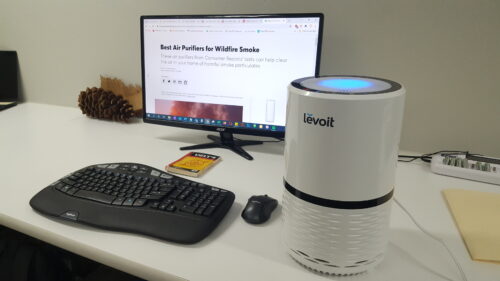


I also purchased a chargeable, battery powered purifiers which were really hard to find. I thought that would be helpful in a power outage or when travelling. I will let you know how it works after I use it for a bit.
Subscribe to be notified about this upcoming article here >>
DYI Air Purifiers for $40-$60
Not as effective as the HEPA or retrofitting your HVAC but they actually do work quite well for the money and ease of setup. Don’t quote me but I think it works to clean about 70% of particulate which is a lot better than doing nothing, especially right now when air quality is over 100 AQI and sometimes more than 200 here in our area.
*Warning: Because your box fan is not built to have a filter you are putting strain on the motor which could be a fire risk. As one video mentions this possibility is 1 in a million, but it still is a possibility, so DYI at your own risk.
Here is a DYI using one air filter but I think the style with two filters may be easier on the motor of the box fan. See the picture below. Also remember to make sure your filter has the arrows going in the right direction for air flow.
The below style seems like it would put a little less pressure on the box fan but over time pressure will increase as the filters get dirty.
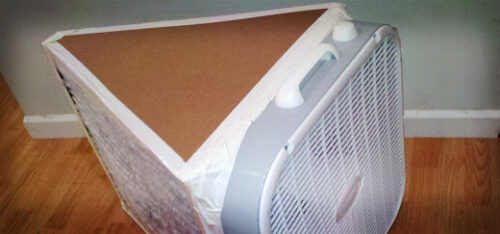


How about plants filtering my air?
(At least they don’t need electricity to help…)
From my view, plants are a great idea, not only for our moods but also because they are like mini air purifiers. The reason why I say mini is because you really need a lot of plants to be as effective in filtering out particulate matter that is under 2.5 microns. However, NASA did prove that certain plants filter chemicals (like formaldehyde) that would be off gassing from your couches or walls, and for that purpose alone, I will always have plants growing in my house. Also, I love the idea of living plants giving me 02 and thriving from my C02. We live in an incredible world!
The skinny: Plants do help air quality, but when it comes to PM2.5 and PM10 from wild fires, you will most likely not have enough plants to fully filter the air fast enough like an air purifier.
Here are some articles on cleaning with plants and what plants to choose.
Are plants effective? Which plants work best? Read – www.organiclawndiy.com/2015/03/cost-effective-air-cleaning-plants.html
They work, but not as much as we hope when it comes to wild fire smoke: www.iqair.com/us/blog/air-quality/plants-for-purifying-air-debunked
Another read about plants and 2.5 micron or smaller particulate: www.smartairfilters.com/en/blog/plants-pm25-pm10-air-pollution-purifier-effective-home/
Lastly… Why should we even consider filtering our air in the Sierra Foothills?
Some information about, PM2.5 and why is it unhealthy in large doses.
Particles in the PM2.5 size range (and below) are able to travel deeply into the respiratory tract, reaching the lungs. Exposure to fine particles can cause short-term health effects such as eye, nose, throat and lung irritation, coughing, sneezing, runny nose and shortness of breath. Exposure to fine particles can also affect lung function and worsen medical conditions such as asthma and heart disease. Scientific studies have linked increases in daily PM2.5 exposure with increased respiratory and cardiovascular hospital admissions, emergency department visits and deaths. Studies also suggest that long term exposure to fine particulate matter may be associated with increased rates of chronic bronchitis, reduced lung function and increased mortality from lung cancer and heart disease. People with breathing and heart problems, children and the elderly may be particularly sensitive to PM2.5. –www.health.ny.gov/environmental/indoors/air/pmq_a.htm
Also:
PM 2.5 refers to a category of particulate pollutant that is 2.5 microns or smaller in size. The average cross-section of a human hair is 50 microns. PM stands for “particulate matter.” The EPA and many health organizations categorize particulate matter by size because different size particles have different health effects. For instance, PM 10 particles (particles less than 10 microns in size) can irritate your nose and eyes, but fewer of these particles penetrate deep into your lungs, so they do not cause the same health problems that smaller micron particles can, although they do increase rates of respiratory disease [Yu-Fei et al., 2016].
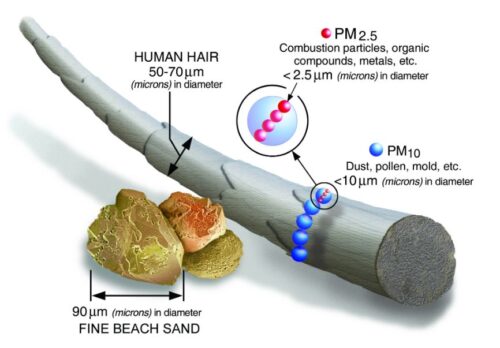


Particles that are 2.5 microns or smaller are considered especially dangerous to human health because they bypass many of our body’s defenses. Nose hair, mucus, and other defenses work to catch these smaller particles before they enter deeper into our bodies. That said, PM 2.5 particles can get into our lungs, where they can reach the alveoli and eventually enter the bloodstream.
People concerned about outdoor air pollution often turn to face masks for protection. Studies have found that masks can in fact reduce the amount of PM 2.5 you inhale, but the mask must be rated to filter out PM 2.5 and it also has to fit well so there are no air gaps [Pacitto et al., 2019].
A more long-term way to protect yourself against high PM 2.5 levels is to vote for elected officials who are in favor of regulating PM 2.5 pollutants. There is scientific evidence to show that EPA regulations on particulate pollutants result in fewer health problems and reduced overall mortality. In U.S. counties where fine particulate pollutants decreased from 1980 to 2000, life expectancy increased even when controlling for other factors [Pope et al., 2009].
Can I filter COVID-19, Coronavirus with a Hepa Filter?
Air purifiers that contain HEPA filters can capture virtually all sizes of solid particles, including particles 0.1 microns in diameter – or the same size as the coronavirus. – www.smartairfilters.com/en/blog/can-air-purifiers-filter-out-the-coronavirus
Also you can filter using your HVAC with a MERV 13 or above. www.wtsp.com/article/news/health/coronavirus/merv-13-filters-are-also-recommended-in-your-home/
In Conclusion
Our air quality right now is awful and this will not be a one time thing. Get yourself a HEPA purifier, upgrade your HVAC, or at least do something DYI.
PM2.5 and below is no joke and I personally think filtering your air is just part of living in California during fire season. Not only that, but consider the fact that we are facing record breaking acres of forest burning, so this is not “how it’s always been.”
Filter your air, do it for yourself and the people around you. Share this information. Remember, a healthy community is a strong community.
Make sure to also read Ray Darby’s Part 1 on filtering wildfire smoke >>


